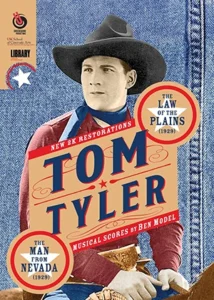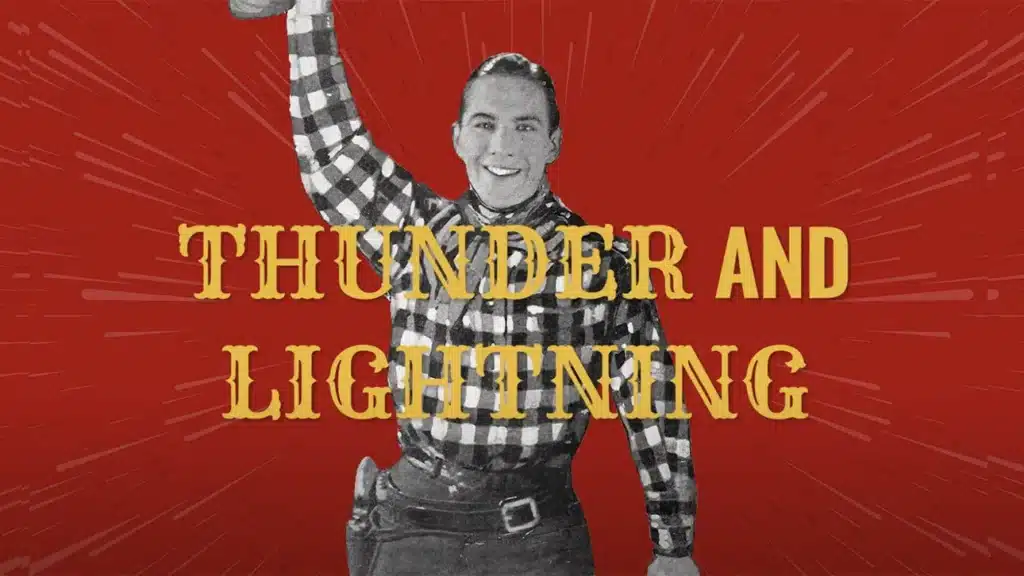
Cowboy hero Tom Tyler rides a horse, swings a fist, and saves a ranch in restored silent westerns The Law of the Plains and The Man from Nevada.
 The Tom Tyler Silent Film Collection J.P. McGowan Undercrank 6 May 2025
The Tom Tyler Silent Film Collection J.P. McGowan Undercrank 6 May 2025
Who was Tom Tyler? This forgotten matinee hero, known mainly for B westerns and serials, receives a bout of resurrection in The Tom Tyler Silent Film Collection, newly on DVD and Blu-ray from Undercrank Productions.
According to the bonus slideshow on the disc, Tom Tyler was born Vincent Markowski to parents who immigrated from Lithuania. Does this mean he was Jewish? If so, he wouldn’t be the first or last to create all-American WASP iconography. He was over six feet tall with wavy hair, clear eyes, aquiline nose, square jaw and beaming smile. While performing a number of strapping he-man jobs like lumberjack, he won prizes as an amateur weightlifter.

One year after arriving in Hollywood, he found himself starring as Tom Tyler in 29 silent B westerns for a company called FBO (Film Booking Offices), which by the end of the 1920s would merge into RKO. The FBO films often teamed him with child star Frankie Darro.
The two films on The Tom Tyler Silent Film Collection hail from Tyler’s final silent period in 1929, when he made eight B westerns for an even smaller company called Syndicate Pictures, later known as Monogram. Both The Law of the Plains and The Man from Nevada are five-reel films produced and directed by J.P. McGowan, written by Sally Winters, and shot by Hap Depew, with James Casey credited as technical director. This probably means Casey directed the camera while McGowan directed the actors.
In addition, both films star largely the same cast, including Natalie Joyce as the damsel in distress, William Nolte as the short comic sidekick and Al Ferguson as a sneering skunk. They’re shot in the same locales and even feature the same ranch. Tyler wears a black or dark hat, despite publicity stills of him in white hat. Perhaps this fashion change marked the transition from FBO to Syndicate. In fact, Tom Tyler would play black-hatted baddies on other occasions, most famously John Ford’s Stagecoach (1939).
There’s Nary a Plain in The Law of the Plains
Honestly, the stories on this double-feature are nothing much, although The Law of the Plains has slightly more going on. It’s more of a South American than a western, as it claims to be set in an unidentified South American country where a revolution is happening.
The film has nothing to say about this. It just shows us two groups of dozens of extras, the Loyalists and Insurrectos, performing distant maneuvers among the picturesque Hollywood; that is, South American hills. Despite the title, there’s nary a plain visible.
We see an American naval ship offshore, ready to send troops to “protect our people and their property.” Within living memory, the audience would have been aware of U.S. Marines occupying or intervening in Cuba, the Philippines, Nicaragua, Honduras, Dominican Republic, Mexico, Panama and, most ongoingly, Haiti.
They were certainly aware of South American revolutions. Therefore, this “western” incorporates the viewers’ sidelong awareness of such activity into its plot.
Tom Tyler plays U.S. Marine Dan O’Brien, who owns a very comfortable ranch and hacienda, as played by somebody’s nice California property. He lives there with his son, Dan Jr. (future director Robert Parrish). Two shady polecats are pretending to buy O’Brien’s property but intend to steal it in the confusion of revolution.
These varmints are played by Ferguson and the director, McGowan, as “Limpy Seagrue, deformed in mind and body”. Limpy’s got what looks like a penciled Fu Manchu ‘stache and tiny goatee. Later, he’ll be bald all over like Daddy Warbucks in the Little Orphan Annie comics.
The singular shock in The Law of the Plains arrives in the first eight minutes, when we see the villains shoot O’Brien down like a dog even though he’d been our cleancut hero. So when the action shifts to “many years later”, Tom Tyler now plays the grown-up Dan, a trail boss herding cattle we never see. The production value extended to the pretty locations and the extras, not livestock.
Descriptions of the plot for The Law of the Plains claim that Dan must avenge his dad’s death and reclaim his property. That sounds reasonable, but no such thing happens, nor does Dan ever appear to figure it out. It’s really about how Dan intervenes to save Limpy’s spunky useless niece (Joyce) from marriage to the other polecat. We won’t spoil how that happens, but you know it does. Reel Four is missing from this Library of Congress print, and we don’t much miss it.
The Man from Nevada
The Man from Nevada is mostly intact, although a couple of brief scenes with the baddie seem eclipsed. This story is set in the US, probably contemporary, and involves a “motherless” family of homesteaders comprising the adult Joyce, two highly freckled little brothers called Wart and Wiggles, the baby Wobbles (we can’t make this up), and the rather weedy and cowardly paterfamilias (Alfred Hewston) who’s being claim-jumped and run off his land, unless our square-jawed hero can do something about it.
You’ll observe that in both films, Tom Tyler’s character decides to intervene without being asked, kind of like the Marines. His solution is largely to meet violence and threats with the same, only more effectively. Again, well, let’s leave it unspelled out, save that the codes of Hollywood’s wild west seem to parallel foreign adventurism.
After this segment of his career, Tom Tyler made the transition to talkies. He usually played someone named Tom in his plentiful 1930s B’s. He co-starred in a Republic series about The Three Mesquiteers during the ’40s, and he was perfect casting in Republic’s serial Adventures of Captain Marvel (1941), officially the first Hollywood adaption of a superhero comic. Then he starred in another comics-based serial, Columbia’s The Phantom (1943).
While Saturday matinee kids knew Tom Tyler as an idol and star, he also popped up in “A” features, sometimes uncredited in one-day roles. After Stagecoach, Ford used him in Drums Along the Mohawk (1939), The Grapes of Wrath (1940), They Were Expendable (1945), She Wore a Yellow Ribbon (1949) and What Price Glory (1952). He had minor roles in “A” westerns like William Wyler’s The Westerner (1940), Raoul Walsh’s San Antonio (1945) and Cheyenne (1947) and Howard Hawks’ Red River (1948). Incredibly, he’s even got cameos in huge productions like Victor Fleming’s Gone with the Wind (1939) and Cecil B. DeMille’s Samson and Delilah (1949). That’s the sign of a well-liked actor.
More significantly, Tom Tyler played outlaw Frank James in both Badman’s Territory (1946), a Randolph Scott oater directed by Tim Whelan, and Samuel Fuller’s I Shot Jesse James (1949). He played the mummy in Christy Cabanne’s The Mummy’s Hand (1940) and Geronimo in George Marshall’s Valley of the Sun (1942). Sadly, he died of an autoimmune condition at 50, when his career was still chugging along.
McGowan, an Australian ex-soldier, is another interesting figure. He directed dozens of episodes of the pioneering serial The Hazards of Helen (1914-15) starring Helen Holmes. He married her and they set up their own production company for many films starring one or both of them. By the time of his association with Syndicated, he’d gotten divorced after ten years of marriage and was on his own. From this point, it was all cowboy B’s all the time, starring the likes of Tom Tyler, Bob Steel, Bob Custer, Buzz Barton, Kermit Maynard and other forgotten Saturday sagebrushers.
The short running times on The Law of the Plains and The Man from Nevada mean the action runs at a clip, and you wouldn’t want them longer. These 2K restorations from 35mm prints are wonderfully clean. The Man from Nevada is tinted. Ben Model provides new scores on an imitation organ.
The impetus for the Kickstarter campaign on this release came from Tyler superfan Maria Della Valle, who produced this disc with Crystal Kui and Model. It’s a good example of how do-it-yourself fans are producing their own releases without expecting major companies to foot a bill for items that would never be considered. This is their bid to make sure Tom Tyler isn’t forgotten.


